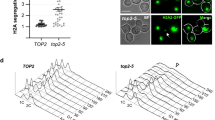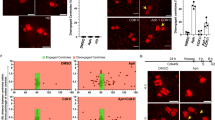Abstract
During chromosome duplication the parental DNA molecule becomes overwound, or positively supercoiled, in the region ahead of the advancing replication fork. To allow fork progression, this superhelical tension has to be removed by topoisomerases, which operate by introducing transient DNA breaks1. Positive supercoiling can also be diminished if the advancing fork rotates along the DNA helix, but then sister chromatid intertwinings form in its wake1,2. Despite these insights it remains largely unknown how replication-induced superhelical stress is dealt with on linear, eukaryotic chromosomes. Here we show that this stress increases with the length of Saccharomyces cerevisiae chromosomes. This highlights the possibility that superhelical tension is handled on a chromosome scale and not only within topologically closed chromosomal domains as the current view predicts. We found that inhibition of type I topoisomerases leads to a late replication delay of longer, but not shorter, chromosomes. This phenotype is also displayed by cells expressing mutated versions of the cohesin- and condensin-related Smc5/6 complex. The frequency of chromosomal association sites of the Smc5/6 complex increases in response to chromosome lengthening, chromosome circularization, or inactivation of topoisomerase 2, all having the potential to increase the number of sister chromatid intertwinings3. Furthermore, non-functional Smc6 reduces the accumulation of intertwined sister plasmids after one round of replication in the absence of topoisomerase 2 function. Our results demonstrate that the length of a chromosome influences the need of superhelical tension release in Saccharomyces cerevisiae, and allow us to propose a model where the Smc5/6 complex facilitates fork rotation by sequestering nascent chromatid intertwinings that form behind the replication machinery.
This is a preview of subscription content, access via your institution
Access options
Subscribe to this journal
Receive 51 print issues and online access
$199.00 per year
only $3.90 per issue
Buy this article
- Purchase on Springer Link
- Instant access to full article PDF
Prices may be subject to local taxes which are calculated during checkout




Similar content being viewed by others
Accession codes
Primary accessions
Gene Expression Omnibus
Sequence Read Archive
Data deposits
Original data files from ChIP-sequencing experiments can be found at http://trace.ncbi.nlm.nih.gov/Traces/sra/, accession number SRP004920, and from ChIP-on-chip experiments at http://www.ncbi.nlm.nih.gov/geo/, accession number GSE26263.
References
Wang, J. C. Cellular roles of DNA topoisomerases: a molecular perspective. Nature Rev. Mol. Cell Biol. 3, 430–440 (2002)
Postow, L., Crisona, N. J., Peter, B. J., Hardy, C. D. & Cozzarelli, N. R. Topological challenges to DNA replication: conformations at the fork. Proc. Natl Acad. Sci. USA 98, 8219–8226 (2001)
Spell, R. M. & Holm, C. Nature and distribution of chromosomal intertwinings in Saccharomyces cerevisiae . Mol. Cell. Biol. 14, 1465–1476 (1994)
Hazbun, T. R. et al. Assigning function to yeast proteins by integration of technologies. Mol. Cell 12, 1353–1365 (2003)
Lindroos, H. B. et al. Chromosomal association of the Smc5/6 complex reveals that it functions in differently regulated pathways. Mol. Cell 22, 755–767 (2006)
Johnson, D. S., Mortazavi, A., Myers, R. M. & Wold, B. Genome-wide mapping of in vivo protein-DNA interactions. Science 316, 1497–1502 (2007)
Bermejo, R. et al. Top1- and Top2-mediated topological transitions at replication forks ensure fork progression and stability and prevent DNA damage checkpoint activation. Genes Dev. 21, 1921–1936 (2007)
Kim, R. A. & Wang, J. C. Function of DNA topoisomerases as replication swivels in Saccharomyces cerevisiae . J. Mol. Biol. 208, 257–267 (1989)
Hiasa, H., DiGate, R. J. & Marians, K. J. Decatenating activity of Escherichia coli DNA gyrase and topoisomerases I and III during oriC and pBR322 DNA replication in vitro . J. Biol. Chem. 269, 2093–2099 (1994)
Mankouri, H. W. & Hickson, I. D. The RecQ helicase-topoisomerase III-Rmi1 complex: a DNA structure-specific ‘dissolvasome’? Trends Biochem. Sci. 32, 538–546 (2007)
Gangloff, S., McDonald, J. P., Bendixen, C., Arthur, L. & Rothstein, R. The yeast type I topoisomerase Top3 interacts with Sgs1, a DNA helicase homolog: a potential eukaryotic reverse gyrase. Mol. Cell. Biol. 14, 8391–8398 (1994)
Hennessy, K. M., Lee, A., Chen, E. & Botstein, D. A group of interacting yeast DNA replication genes. Genes Dev. 5, 958–969 (1991)
Redon, C. et al. Yeast histone 2A serine 129 is essential for the efficient repair of checkpoint-blind DNA damage. EMBO Rep. 4, 678–684 (2003)
Pommier, Y. et al. Repair of topoisomerase I-mediated DNA damage. Prog. Nucleic Acid Res. Mol. Biol. 81, 179–229 (2006)
Kjeldsen, E., Svejstrup, J. Q., Gromova, I. I., Alsner, J. & Westergaard, O. Camptothecin inhibits both the cleavage and religation reactions of eukaryotic DNA topoisomerase I. J. Mol. Biol. 228, 1025–1030 (1992)
Koster, D. A., Palle, K., Bot, E. S., Bjornsti, M. A. & Dekker, N. H. Antitumour drugs impede DNA uncoiling by topoisomerase I. Nature 448, 213–217 (2007)
Ciosk, R. et al. Cohesin’s binding to chromosomes depends on a separate complex consisting of Scc2 and Scc4 proteins. Mol. Cell 5, 243–254 (2000)
Ampatzidou, E., Irmisch, A., O’Connell, M. J. & Murray, J. M. Smc5/6 is required for repair at collapsed replication forks. Mol. Cell. Biol. 26, 9387–9401 (2006)
Branzei, D. et al. Ubc9- and mms21-mediated sumoylation counteracts recombinogenic events at damaged replication forks. Cell 127, 509–522 (2006)
Sollier, J. et al. The Saccharomyces cerevisiae Esc2 and Smc5–6 proteins promote sister chromatid junction-mediated intra-S repair. Mol. Biol. Cell 20, 1671–1682 (2009)
Krejci, L. et al. DNA helicase Srs2 disrupts the Rad51 presynaptic filament. Nature 423, 305–309 (2003)
Veaute, X. et al. The Srs2 helicase prevents recombination by disrupting Rad51 nucleoprotein filaments. Nature 423, 309–312 (2003)
Gangloff, S., Soustelle, C. & Fabre, F. Homologous recombination is responsible for cell death in the absence of the Sgs1 and Srs2 helicases. Nature Genet. 25, 192–194 (2000)
Liberi, G. et al. Rad51-dependent DNA structures accumulate at damaged replication forks in sgs1 mutants defective in the yeast ortholog of BLM RecQ helicase. Genes Dev. 19, 339–350 (2005)
Cocker, J. H., Piatti, S., Santocanale, C., Nasmyth, K. & Diffley, J. F. An essential role for the Cdc6 protein in forming the pre-replicative complexes of budding yeast. Nature 379, 180–182 (1996)
Hamer, L., Johnston, M. & Green, E. D. Isolation of yeast artificial chromosomes free of endogenous yeast chromsomes: Construction of alternate hosts with defined karyotypic alterations. Proc. Natl Acad. Sci. USA 92, 11706–11710 (1995)
Lengronne, A. et al. Cohesin relocation from sites of chromosomal loading to places of convergent transcription. Nature 430, 573–578 (2004)
Baxter, J. & Diffley, J. F. Topoisomerase II inactivation prevents the completion of DNA replication in budding yeast. Mol. Cell 30, 790–802 (2008)
Koshland, D. & Hartwell, L. H. The structure of sister minichromosome DNA before anaphase in Saccharomyces cerevisiae . Science 238, 1713–1716 (1987)
Outwin, E. A., Irmisch, A., Murray, J. M. & O’Connell, M. J. Smc5-Smc6-dependent removal of cohesin from mitotic chromosomes. Mol. Cell. Biol. 29, 4363–4375 (2009)
Katou, Y., Kaneshiro, K., Aburatani, H. & Shirahige, K. Genomic approach for the understanding of dynamic aspect of chromosome behavior. Methods Enzymol. 409, 389–410 (2006)
Katou, Y. et al. S-phase checkpoint proteins Tof1 and Mrc1 form a stable replication-pausing complex. Nature 424, 1078–1083 (2003)
Rosenfeld, S. Characteristics of transcriptional activity in nonlinear dynamics of genetic regulatory networks. Gene Regul. Syst. Biol. 3, 159–179 (2009)
Piatti, S., Bohm, T., Cocker, J. H., Diffley, J. F. & Nasmyth, K. Activation of S-phase-promoting CDKs in late G1 defines a “point of no return” after which Cdc6 synthesis cannot promote DNA replication in yeast. Genes Dev. 10, 1516–1531 (1996)
Lengronne, A., Pasero, P., Bensimon, A. & Schwob, E. Monitoring S phase progression globally and locally using BrdU incorporation in TK+ yeast strains. Nucleic Acids Res. 29, 1433–1442 (2001)
Sjögren, C. & Nasmyth, K. Sister chromatid cohesion is required for postreplicative double-strand break repair in Saccharomyces cerevisiae. Curr. Biol. 11, 991–995 (2001)
Acknowledgements
We thank K. Nasmyth, J. Haber, E. Green and X. Zhao for yeast strains and the BEA core facility at Karolinska Institutet for help with ChIP on chip. Financial support: Strategic Japanese-Swedish Cooperative Program from JST, SSF and Vinnova (C.S. and K.S.); please see Supplementary Information for additional support.
Author information
Authors and Affiliations
Contributions
A.K. performed the PFGE-based assays; A.K. and T.K. the plasmid assays; A.K., H.B.-L. and K.J. the ChIP-on-chip; K.J., Y.K. and K.S. the ChIP sequencing. T.I. and K.S. carried out the computational analysis and C.S. the segregation experiment. H.B.-L., L.S., K.S. and C.S. initiated the study, A.K., K.S. and C.S. continued and finalized its design. A.K. and C.S. wrote the paper. All authors analysed data, discussed the results and commented on the manuscript.
Corresponding author
Ethics declarations
Competing interests
The authors declare no competing financial interests.
Supplementary information
Supplementary Information
The file contains Supplementary Text, Supplementary Tables 1-2, Supplementary Figures 1-11 and additional references. (PDF 1704 kb)
Rights and permissions
About this article
Cite this article
Kegel, A., Betts-Lindroos, H., Kanno, T. et al. Chromosome length influences replication-induced topological stress. Nature 471, 392–396 (2011). https://doi.org/10.1038/nature09791
Received:
Accepted:
Published:
Issue Date:
DOI: https://doi.org/10.1038/nature09791
This article is cited by
-
Molecular Mechanisms of HIV-1 Latency from a Chromatin and Epigenetic Perspective
Current Clinical Microbiology Reports (2023)
-
Smc5/6 silences episomal transcription by a three-step function
Nature Structural & Molecular Biology (2022)
-
Genome folding through loop extrusion by SMC complexes
Nature Reviews Molecular Cell Biology (2021)
-
Smc5/6 functions with Sgs1-Top3-Rmi1 to complete chromosome replication at natural pause sites
Nature Communications (2021)
-
Creating a functional single-chromosome yeast
Nature (2018)
Comments
By submitting a comment you agree to abide by our Terms and Community Guidelines. If you find something abusive or that does not comply with our terms or guidelines please flag it as inappropriate.



